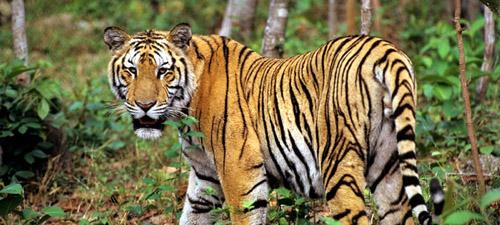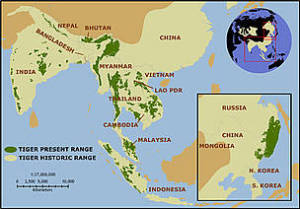Tiger-poaching in Thailand is on the rise

By Sacha Chadwick
Wildlife crime is defined as any violation of a criminal law intended to protect wildlife. Researchers Kristie Blevins and Terry Edwards state that poaching is one of the most notable wildlife crimes. Recent news articles have shown that tiger poaching in Thailand has risen and continues to grow with each passing day because of the illegal trade in tiger parts.
The U.S. Fish and Wildlife Services define illegal wildlife trade as the “unsustainable, harming wild populations of animals and plants and pushing endangered species toward extinction.” While there is a solid definition of illegal animal trade, the definition for poaching is more loosely explained. Blevins and Edwards defines poaching as “taking a wild resource out of season or through an illegal means.” This is important to understand, because researchers and journalists often use these terms interchangeably, despite the definitions being different.
International wildlife trade has been recorded as far back as the 19th century. Researcher Joonmoo Lee has stated that in 1992 “according to the U.S. Fish and Wildlife service, the international wildlife trade was a $5 billion industry, with 25% of the trades being illegal.” However, as Lee also states, the wildlife trading industry has rapidly grown and the amount of illegally traded animals will continue to grow. This is particularly seen in Thailand.

Thailand is a nation rich with culture and attractions. One of the known animals to inhabit Thailand’s mountainous regions is the Indochinese tiger. The Indochinese tiger is most commonly found in Thailand, however, the World Wildlife Federation has stated that there are only approximately 300 known Indochinese Tigers left in Thailand. This is due to the high level of tiger poaching occurring throughout this area. Wild tigers are poached due to the increasing use of animal body parts for medicine or tonics. The various tiger’s parts are even used for home décor, or for food. As a result, the Indochinese tiger has become an endangered species and Thai police efforts to preserve these animals have increased.
As of 2012, there have been increased cases of tiger poaching; therefore several organizations have made it their goal to prevent these acts. In Thailand, the Huai Kha Khaeng Wildlife Sanctuary was established for this reason. This wildlife conservation project worked with Thai police officers in hopes of increasing enforcement in their region. As a result, a poaching gang leader was sentenced to five years imprisonment when Thai police busted a poaching ring.
Despite the increased effort to decrease tiger poaching in Thailand, more can still be done. Recent Thai news articles have stated that the wildlife sanctuary found it difficult to contain large amounts of rescued tigers in one area. One such “sanctuary,” called the Tiger Temple, was recently shown to have abused rescued tigers and forced-bred tigers, without a license. As a result, many tigers are set free in the wild, and many continued to be poached, or found dead. If Thai police and various other organizations can continue their efforts to protect Indochinese tigers, there is hope that these animals may stay protected and continue to live within their natural habitat without fear of being poached.
 Sacha Chadwick is a student in the International Crime and Justice Masters Program at John Jay College of Criminal Justice. Her interests include wildlife crimes and countries’ compliance and non-compliance with the Kyoto Protocol.
Sacha Chadwick is a student in the International Crime and Justice Masters Program at John Jay College of Criminal Justice. Her interests include wildlife crimes and countries’ compliance and non-compliance with the Kyoto Protocol.